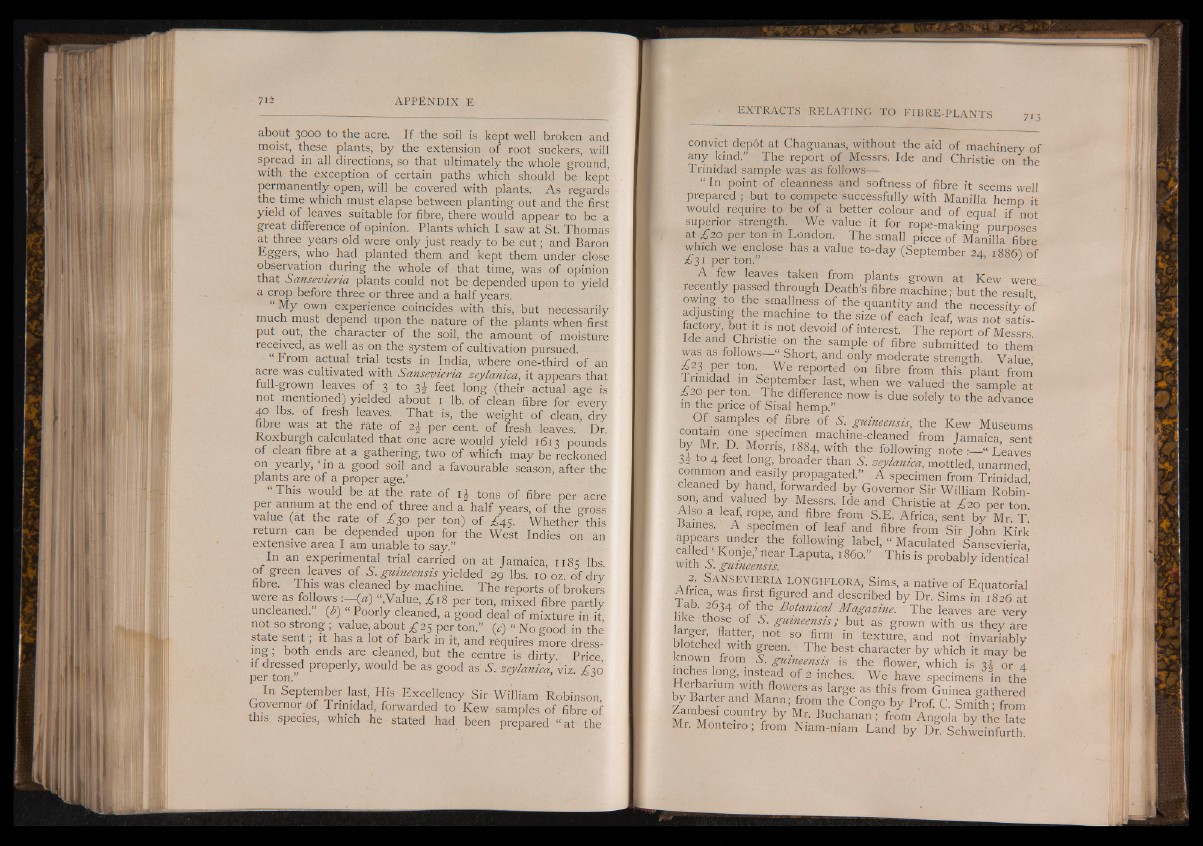
7 là A p p e n d i x è
about 3000 to the acre. If the soil is kept well broken and
moist, these plants, by the extension of root suckers, will
spread in all directions, so that ultimately the whole ground,
with the exception of certain paths which should be kept
permanently open, will be covered with plants. As regards
the time which must elapse between planting out and the first
yield of leaves suitable for fibre, there would appear to be a
great difference of opinion. Plants which I saw at St. Thomas
at three years old were only just ready to be cu t; and Baron
T§Lers, who had planted them and kept them under close
observation during the whole of that time, was of opinion
that Sansevieria plants could not be depended upon to yield
a crop before three or three and a half years.
My own experience coincides with this, but necessarily
much must depend upon the nature of the plants when first
put out, the character of the soil, the amount of moisture
received, as well as on the system of cultivation pursued.
From actual trial tests in India, where one-third of an
acre was cultivated with Sansevieria zeylanica, it appears that
full-grown leaves of 3 to 31 feet long (their actual age is
not mentioned) yielded about 1 lb. of clean fibre for every
40 lbs. of fresh leaves. That is, the weight of clean, dry
fibre was at the rate of per cent, of fresh leaves. Dr.
.Roxburgh calculated that one acre would yield 1613 pounds
of clean fibre at a gathering, two of winch may be reckoned
on yearly, ‘ in a good soil and a favourable season, after the
plants are of a proper age.’
This would be at the rate of 1 £ tons of fibre per acre
per annum at the end of three and a half years, of the gross
value (at the rate of ¿30 per ton) of ¿45. Whether this
return can be depended upon for the West Indies on an
extensive area I am unable to say.”
In an experimental trial carried on at Jamaica, 1185 lbs.
of green leaves of 5 . guineensis yielded 29 lbs. 10 oz. of dry
fibre. This was cleaned by machine. The reports of brokers
were as follows (a) “.Value, ¿18 per ton, mixed fibre partly
uncleaned, (b) “ Poorly cleaned, a good deal of mixture in it
not so strong; value, about £25 per ton.” (c) “ No good in the
state sent; it has a lot of bark in it, and requires more dress*
mg; both ends are cleaned, but the centre is dirty Price
if dressed properly, would be as good as A zeylanica, viz ¡HI
per ton. J
In September last, His Excellency Sir William Robinson
Governor of Trinidad, forwarded to Kew samples of fibre of
this species, which he stated had been prepared “ at the
convict dépôt at Chaguanas, without the aid of machinery of
any kind.” The report of Messrs. Ide and Christie on the
Trinidad sample was as follows—
“ In point of cleanness and softness of fibre it seems well
prepared ; but to compete successfully with Manilla hemp it
would require to be of a better colour and of equal if not
superior strength. We value it for rope-making purposes
at £20 per ton in London. The.small piece of Manilla fibre
which we enclose has a value to-day (September 24, 1886) of
£31 per ton. ^ '
A few leaves taken from plants- grown at Kew were
recently passed through Death’s fibre machine ; but the result
owing to the smallness of the quantity and the necessity of
adjusting the machine to the size of each leaf, was not satisfactory,
but it m not devoid of interest. The report of Messrs
Ide and Christie on the sample of fibre submitted to them
was as follows—- Short, and only moderate strength. Value'
^23 per ton. We reported on fibre from this plant from
Trinidad m September last, when we valued the sample at
£20 per ton. The difference now is due solely to the advance
m the price of Sisal hemp.
Of samples of fibre of A. guineensis, the Kèw Museums
bv Mr" Dn MSpeame0n0 mad?int by Mr D. Morris, 1884, with thecl efaonlleodw ing n o tJea maicLa,e asveenst
32 to 4 feet long, broader than A. zeylanica, mottled/unarmed
common and easily propagated.” A specimen from Trinidad’
cleaned by hand, forwarded by Governor Sir William Robinson,
and valued by Messrs. Ide and Christie at £20 per ton.
Also a leaf, rope, and fibre from S.E. Africa, sent by Mr T
mines. A specimen of leaf and fibre from Sir Tohn Kirk
the Tfollowîng label, g Maculated Sansevieria,
called Konje, near Laputa, 1860.” This is probably identical
with A. guineensis.
2. S a n s e v i e r i a LONGIFLORA, Sims, a native of Equatorial
Africa, was first figured and described by Dr. Sims in 1826 at
l ab 2634 of the Botanical Magazine. The leaves are very
, those of S', guineensis; but as grown with us they are
1blo1tc1he Hd wHithI grne0etn . S° Tfhirem b eisnt ctheaxrtaucrtee>r abnyd wnhoicth iint vmaraiya bbley
known from A. guineensis -is the flower, which is- 3 A or 4
inches long, instead of 2 inches. We have specimens in the
I S S S T m r S as Iarge as this from Guinea gathered
by Barter and Mann; from the Congo by Prof. C. Smith; from
èMTr. ÎMSonnStemiro ; ffr om NNria‘ mBu-mchaamn a?L a; nfdro ibny A DnrS. oSlac hbwye tinhfeu rlathte.